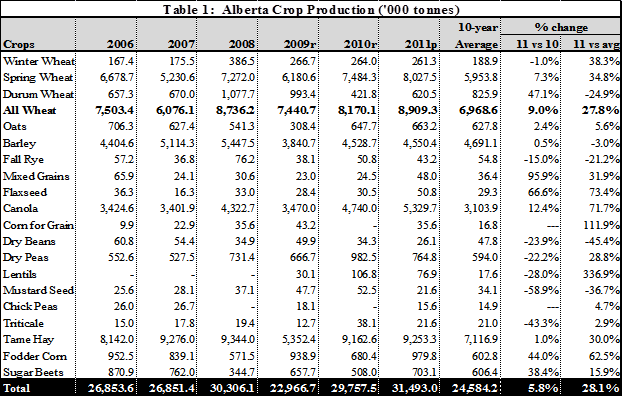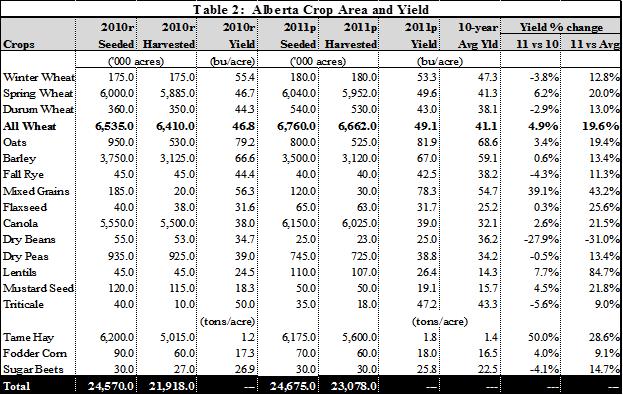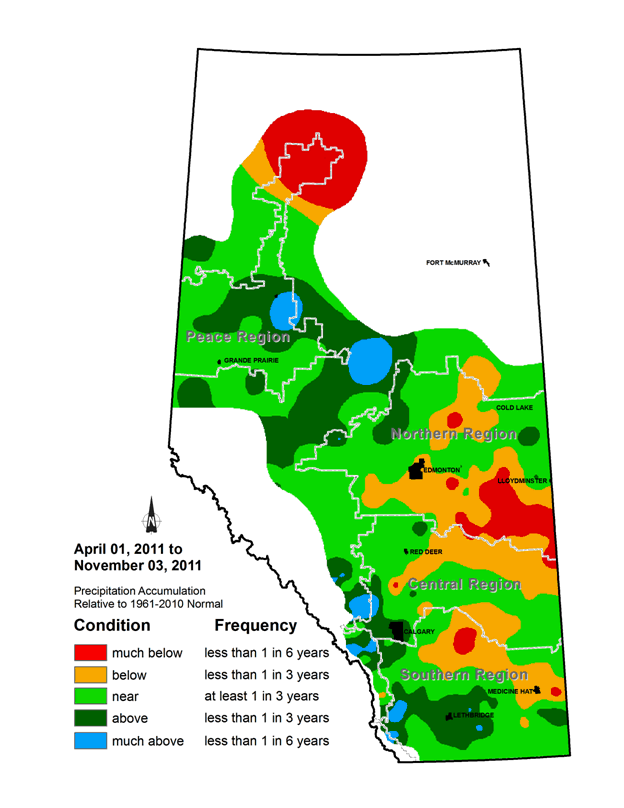| |
Insects and crop diseases | Forage and pasture | Alberta crop production, 2011 | Alberta forage production, 2011 I Alberta crop production tables | Precipitation Map
Overview
This report presents a review of the crop season and an analysis of crop production statistics for 2011. In addition, a precipitation map for the 2011 crop season is attached for reference.
The 2011 Crop Season
Despite the challenging crop growing conditions in the province for the 2011 crop year, the results were favourable. Provincial average yields were above their respective 10-year averages, with normal to above average crop quality.
In 2011, producers were off to a slow start across the province. The cool temperatures in March and April and several precipitation events in the spring have resulted in a slow snow melt and delayed soil dry down and warming. Excessive moisture was a problem in most regions with 17 per cent of the province rating surface soil moisture as excessive. The estimated provincial seeding progress, as of May 19, 2011, was 57 per cent complete, compared to 80 per cent in most years. Additionally, spring frost slowed down crop development, and resulted in some reseeding.
In June, the province saw a return to cooler, showery weather. Despite the challenging conditions earlier that year, producers were able to complete seeding in late June. Seeding progress was similar to 2010 but slightly behind long term historical averages. The rain received in June and July across the province caused soil moisture reserves to be adequate to excessive in all regions across the province, specifically in the western parts of the Central Region. Overall, crop development was mostly 10 – 14 days behind normal in most areas of the province except for the South Region, where the crops were delayed 14 – 17 days due to cool temperatures in June and July. Crop condition ratings were well above long term averages at the end of July.
By early August, precipitation accumulation had largely been near to above average in most areas, except the northern Peace, along with pockets of the North East and Southern Regions that were below average. In terms of surface moisture, there were reported areas with excessive amounts in all regions, with the Peace Region, North East and North West Regions being extremely wet. At the end of August, hot and dry weather in some location in South Region resulted in crops approaching maturity quickly, even so that early harvest operations were underway. As of August 25, crop harvest was estimated to be six per cent completed across the province.
The warm and dry weather across the province during September brought crop maturity and harvest progress, with the additional benefit of above average quality. Patches of light frost, with little or no crop damage, occurred in all regions except Central in early September. During the late September killing frosts occurred across much of the Central and North East regions. As of September 22, crop harvest was estimated to be 45 per cent complete with large variations between regions due to delays in maturity caused by the cool early seasonal weather.
In October, damp and cool temperatures delayed crop maturity and harvest. Completion of harvest this year was about one week behind most years. The sunny weather with above seasonal temperatures in October allowed most producers to wrap up harvest for the year. However, damp weather in early November, resulted in many crops in the northern part of the province taken off wet and required drying. Provincially, about 99 per cent of the crop was in the bin, as of November 3, 2011.
Insects and Crop Diseases
With respect to pest infestations in 2011, the most noticeable damage was from cabbage seedpod weevils, mainly in the Southern Region. This potentially could become a problem in 2012 on irrigation land. Grasshoppers were moderate to severe in some areas in the Peace, north central Alberta and grassland areas. Wheat midge numbers were low for 2011 with most occurrences in the southern region and peace country. Lygus had higher incidences in 2011 and could be problematic in 2012.
Damp weather conditions in spring and early summer contributed to crop diseases in many areas. In particular, clubroot on canola was prevalent in the Edmonton area and was also found in other parts of the province. Many incidents of ergot were reported across the province, on wheat, barley and oats, particularly in Southern and Central Regions. There were also incidents of blackleg in the province. Other disease problems were stripe rust and tan spot on wheat, and net blotch on barley.
Forage and Pasture
In early May, pasture growth had been slow due to the cool spring conditions in the central region and the north-east region. May pasture was rated as three per cent poor, 20 per cent fair, 63 per cent good, and 14 per cent excellent.
In June, pasture ratings had improved with the rain, although growth in many areas was still significantly behind normal. By end of June pasture crop ratings were zero per cent poor, eight per cent fair, 48 per cent good and 44 per cent excellent. In July, pasture rating was mostly unchanged.
The moisture received in early August helped improve pasture growth, allowing for more cattle grazing. Pasture conditions, as of August 25, 2011, were rated three per cent poor; 23 per cent fair; 45 per cent good and 29 per cent excellent.
With respect to tame hay, production was up from 2010 due to well above average yields and bigger harvested area. This was mainly as a result of favorable moisture reserves in early August. Rain affected the progress of first cut haying operations with quality rated as fair to good. The second cut had no rain and quality was good.
Alberta Crop Production, 2011
Total 2011 Crop Production Increased in Alberta
On December 6, 2011, Statistics Canada released its report entitled "November Estimates of Production of Principal Field Crops, Canada, 2011". Based on the report, total 2011 production of principal field crops in Alberta was estimated at 31.5 million tonnes, six per cent higher than 2010, and 28 per cent above the 10-year average (see Table 1). This was due to a combination of higher yields and an increase in harvested area for several crops. Crop growing conditions were mainly favorable in most areas of the province. Provincial average yields were above their respective 10-year averages (see Table 2). The warm, dry weather across the province provided producers with the opportunity to make good harvest with above average crop quality. Total seeded area of principal field crops in the province was relatively unchanged from 2010, while harvested acreage increased by more than five per cent.
Production by Crop Type, Alberta
Total production of spring wheat increased seven per cent, to 8.0 million tonnes. This stemmed from higher yields, and to a lesser extent, an increase in harvested area. The provincial average yield was estimated at 49.6 bushels per acre, up six per cent from 2010, while harvested area increased one per cent, to six million acres. For durum wheat, production increased 47 per cent, to 620,500 tonnes, as a result of a marked increase (51 per cent) in harvested area. Regarding yields, the provincial average was estimated at 43.0 bushels per acre, down three per cent from 2010. Overall, total production of all wheat reached 8.9 million tonnes, an increase of nine per cent over 2010.
In 2011, total barley production rose one per cent, to 4.6 million tonnes. The provincial average yield for barley was 67.0 bushels per acre, or one per cent higher than in 2010, while harvested area was relatively flat. For oats, total production increased by two per cent last year and reached 663,200 tonnes. This was due to higher yields that was estimated at 81.9 bushels per acre, or three per cent higher than in 2010, while the harvested area was down one per cent.
Total canola production increased 12 per cent from 2010, to a record 5.3 million tonnes. This was attributed to a combination of higher yields and a larger harvested area. For 2011, the harvested acreage was a record 6.2 million acres. The provincial average yield is 39 bushels per acre, or three per cent above 2010.
In 2011, total production of dry peas declined 22 per cent, to 764,800 tonnes, due to lower harvested area and slightly lower yields. The provincial average yield was 39 bushels per acre, down one per cent from 2010, but still well above 10-year average.
2011 Crop Production, Canada
Based on the November estimates, total 2011 Canadian production was 18.0 million tonnes for spring wheat, 4.2 million tonnes for durum, 7.8 million tonnes for barley, 3.0 million tonnes for oats, 14.2 million tonnes for canola, and 2.1 million tonnes for dry peas (see Figure 1).
Alberta Forage Production, 2011
Total tame hay production in Alberta in 2011 was estimated at 9.25 million tonnes, based on the Statistics Canada report “November Estimate of Production of Principal Field Crops, Canada, 2011”. This was up one per cent from 2011, and 30 per cent above the 10-year average. The higher production was mainly as a result of higher yields and an increase in harvested area.
Based on a survey conducted by the Statistics and Data Development Branch of Alberta Agriculture and Rural Development, total greenfeed production in the province declined 25 per cent from 2010, to 1.3 million tonnes. The lower production was attributed to a marked decline in harvested area. For silage, total production was estimated at 3.9 million tonnes, down 2 per cent from 2010, due to lower yield.
Total area harvested for greenfeed declined 28 per cent from 2010, to 412,000 acres, while silage acreage increased one per cent, to 575,000 acres. The mainly favorable crop growing conditions in 2011 contributed to higher greenfeed yields than in 2010. Barley and oats were the major crops harvested for greenfeed and silage production, although significant acreages of mixed grains, and some spring wheat and triticale were also taken off as forages.
Contacts
For additional information relating to this report, please do not hesitate to contact the subject area specialist.
Alberta Agriculture and Rural Development
Economics and Competitiveness Division
Statistics and Data Development Branch
Lukas Matejovsky
Crop Statistician
780-422-2887
Email: lukas.matejovsky@gov.ab.ca
Alberta Crop Production Tables



Precipitation Map

Source: Alberta Agriculture and Rural Development, Environmental Stewardship Division, Technology and Innovation Branch |
|